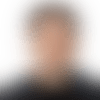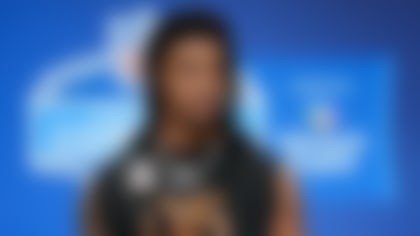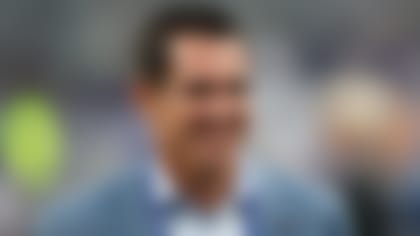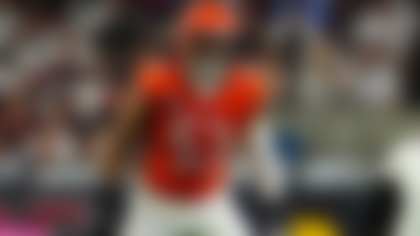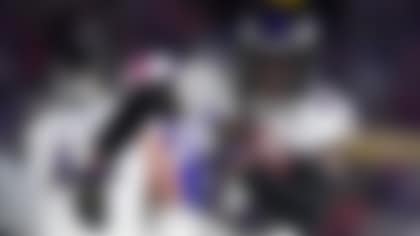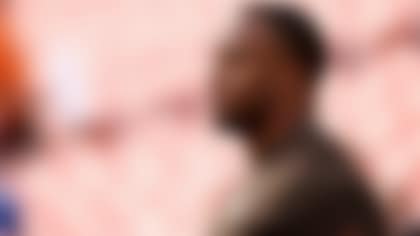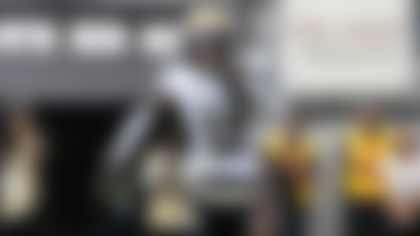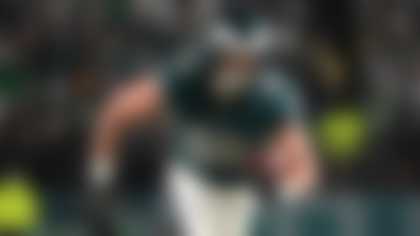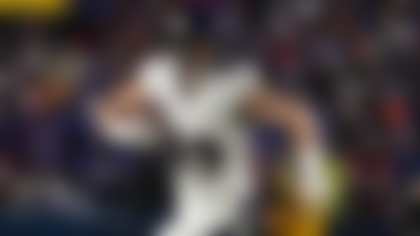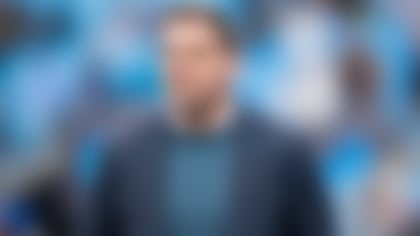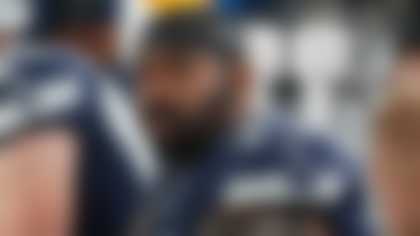"Come on, Mo! Let's get your ass kicked!"
Tony Romo wants to stop Morris Claiborne's incessant honking. On another indistinguishable Oxnard, California, afternoon during the dog days of training camp, Romo revels in the chance to give his team life by talking trash, stepping up to the line and calling his shot. He used to scratch his competitive itch during offseason pickup basketball, golf and soccer, but his history of back trouble prevents all that now.
Moments later, Romo delivers a high arcing pass down the sideline that receiver Terrance Williams catches over Claiborne. Romo smiles wide as Cowboys defenders groan. They have seen it all before. They know they won't see it forever.
Romo is entering the 14th season of a paradoxical career. No player of his era has been more overexposed and underrated. He has Hall of Fame credentials that could be pushed over the top with one final great season. There is no better potential NFL story than a narrative-busting Romo campaign that ends at Super Bowl LI in Houston. It would force us to recognize how well Romo has played the last 10 years.
From underdog to goat
Tony went Full Romo from the jump. What's changed is how we look at him.
Most of America met Romo when he replaced Dallas starter Drew Bledsoe after halftime on "Monday Night Football" against the Giants on Oct. 23, 2006. Romo's first throw that night, deflected by Michael Strahan, was intercepted. He threw two more picks. But he also jump-started a lifeless offense, racking up 227 yards and two scores in just one half of play. It wasn't pretty, but it was more entertaining than any of the eight mediocre options the team trotted out after Troy Aikman retired in 2001. (Remember Chad Hutchinson, Anthony Wright or Ryan Leaf in Dallas?)
We were hooked, as was then-Cowboys coach Bill Parcells. Bledsoe never played another snap. It was as if the Football Gods sensed we needed an antidote to the exceptional but bland quarterback kings of the day: Tom Brady, Peyton Manning and Carson Palmer. Romo's first NFL start came six days later, on "Sunday Night Football," during NBC's initial season with the package -- and he rallied from a two-touchdown deficit against Carolina with 25 fourth-quarter points, a Cowboys record at the time.
The network pounced. Since that day, no team has come close to the Cowboys' 34 appearances on Sunday night. Ten of the top-15 games in SNF ratings history entering last season involved the Cowboys. That doesn't happen with Quincy Carter.
One year to the day after his first start, he signed a contract with more guaranteed money than Peyton Manning's deal. Romo's relationship with country singer Carrie Underwood was already over by then. He was my wife's first favorite football player. He was leading the offense for the best team in football. He was an overnight superstar.
A decade in the spotlight has seen Romo go from underdog to goat and back. He has played the hero and been the victim of many cruel endings. He has become a symbol for coming up short in the big moment, despite constantly papering over his organization's flaws.
Romo ranks second all-time in net yards per attempt, behind only Manning. In a golden era for quarterbacks, Romo finished in the top five of ESPN's underrated QBR stat four times going back to 2006. (Eli Manning, for comparison, finished in the top 10 twice in that span.) Yet, Romo's been at the center of our football attention for so long that we've taken him for granted, not recognizing he's one of the best of his time.
Romo is 36 and coming off a season in which he fractured his collarbone twice. But he's also heading the Cowboys' most loaded offensive roster since they went 13-3 with Terrell Owens in 2007.
He is the once-popular hit show that lost its edge and some fans along the way. Now it's Romo's time for the sentimental and triumphant final run that forces everyone to re-evaluate his career.
A momentous mistake
Before we get to that, let's revisit the play that gave rise to Romo's reputation as the NFL's Charlie Brown -- a play that shares DNA with the one that Lucy made famous. Romo's bobbled snap in the Wild Card Round in Seattle after the 2006 season inevitably will be part of any career retrospective, but it has gained an outsized importance because of its aftermath. Parcells blamed his retirement on the heartbreak stemming from the play, and plenty of fans still hold it against Romo, despite some obvious points:
1) Parcells never should have had his starting quarterback as his field-goal holder.
2) The Cowboys were only in the playoffs because Romo led them there. He led the league in yards per attempt in his first season as the starter. They were only in position for the field goal because of Romo's gutsy drive after Dallas' defense blew the lead.
The most telling part of the saga came the following month. With the NFL world crashing around him, Romo insisted on holding for field goals at the Pro Bowl. Romo seemed less like a glutton for punishment and more like someone who understood what comes with being an NFL quarterback.
"I really don't think he worries about that appreciation. He's worried about how he can be better," Jason Witten, Romo's longtime teammate, told me this month.
Still, that play set the template for Cowboys coverage over the decade: Ignore the big picture and blame Romo for the organization's sins. It obscures the fact that he's constantly been tasked with carrying lackluster defenses. Romo has led the Cowboys' offense to a top-five finish in scoring in half the seasons he's been the primary starter. The Dallas defense, meanwhile, has finished in the top 12 in points allowed once in those years. (That season, 2009, included one of Romo's playoff wins.)
The bobbled snap predisposed us to see Romo as a tragic figure, and some of his season-ending losses were indeed tough to stomach. But Dallas' top-heavy roster construction has hurt the team more than any Romo gaffe or pass. The Cowboys get great names to put on season tickets, but they continually struggle to develop the middle class of an NFL roster. That's one reason the Cowboys are 78-49 with Romo under center since he took over and 7-20 without him.
This season's suspension-plagued defense threatens to weigh Romo down again. But his teammates on offense are so good this time that it might not matter.
An offense built to win
The Jerry Jones regime has rightly been criticized for some of the Texas-sized contracts handed out over the last 10 years. But the family-run personnel department deserves major kudos for building the best offensive line in football. Tackle Tyron Smith, center Travis Frederick and guard Zack Martin are the keys. They are equally proficient protecting Romo and blowing open holes on the ground. Any group that can make Darren McFadden look like Tony Dorsett while Matt Cassel is at quarterback is doing something right.
Dez Bryant's return to health after an injury-plagued 2015, evidenced by his effort in the team's preseason opener, gives Romo a top-10 receiver. Rookie running back Ezekiel Elliott is one of the most complete backs to enter the league since Adrian Peterson. Cole Beasley has settled into his role as a solid slot receiver, and tight end Witten is likely headed for Canton because of his connection with his quarterback.
"Anytime he's out there, you enjoy it," Witten told me. "Especially the communication. The non-verbal communication."
The entire Cowboys offense should be able to speak in shorthand because of how long it's been together. The starting offensive line returns intact. Tackles Smith and Doug Free have played together for five years. Martin has played next to Frederick since Martin entered the league in 2014. Bryant, Beasley and Williams enter their fourth season together. Even Witten's backup, Gavin Escobar, has been around since 2013.
It is so rare for an NFL team to achieve this sort of talented continuity. The Cowboys know it can only last so long, especially with Romo facing his football mortality.
"You appreciate it more," Romo told reporters earlier this month about his return to football. "I think you just, you love the competition. I know I love to compete and I love to see how good I can be."
Last call for the Hall
"We feel the urgency," receiver Brice Butler told me after a recent walk-through. "But honestly, Tony and [coach] Jason [Garrett] probably feel that more than anyone else."
Romo's career can be divided cleanly into four parts. From 2003 to 2006, he was working his way up the depth chart. From 2006 to 2010, when he first suffered a broken collarbone, Romo was a top-five quarterback who endured some cosmically bad luck in big games. There was more variance in Romo's play after the injury, but the Cowboys' mediocre defense was a constant.
Now we've entered Romo's twilight years. Bad photo angles aside, Romo isn't guaranteed to age on the field as gracefully as Brady has. The two share similarities in career paths (beating out Drew Henson, taking a job from Drew Bledsoe), but Romo feels more human. He doesn't seem the type for avocado ice cream.
"I don't know how much longer he's gonna play, but he's still at optimum," Butler said. "So we're just trying to keep it going while he's there."
But he remains engaged on the practice field. Even when third-string quarterback Jameill Showers takes snaps, Romo stands on top of the action like an assistant coach, barking out encouragement and tips. The transparent joy with which Romo plays football is a huge reason why fans fell for him in the first place.
"Tony loves to play. That's line one when you talk about Tony Romo. He's a great competitor," Garrett said this month. "He loves to practice this game. He loves to be in competitive situations on the practice field."
Many of Romo's receivers and coaches spoke about Romo's energy on the practice field as his biggest asset.
"It's awesome having Romo out there," defensive coordinator Rod Marinelli said. "We have to be on the screws in our coverage or our disguises, or he'll pick you apart."
The Cowboys Star and Romo have become synonymous over this decade, but everyone knows the end is nearing. There is even a buzzy young quarterback on the team, rookie Dak Prescott, who inevitably will become a little too popular with the Cowboys fanbase.
The unforgiving creep of time infuses this season with poignancy. A long playoff run with an explosive offense would change so much. It would put an exclamation point on a worthy Hall of Fame résumé. However, if this fourth phase of Romo's career is marked by decline or injury, he risks being unfairly remembered for the games he didn't win. Every sack of Romo will include that awful second where fans wonder if he's down for the count.
Sure, it's hard to see the Cowboys as underdogs. They are still America's Team, insofar as Americans enjoys rooting against them together. Romo's final act could transcend that.
We have made enough bad jokes on Twitter and seen enough painful losses. It would be so satisfying to watch one of this generation's greatest players erase that bobbled snap to end an incredibly cinematic career John Elway-style. Romo hasn't given up the chase:
"Getting to a point where, one day in your career, you get to be that version you always wanted to be. That's what we're trying to do."
